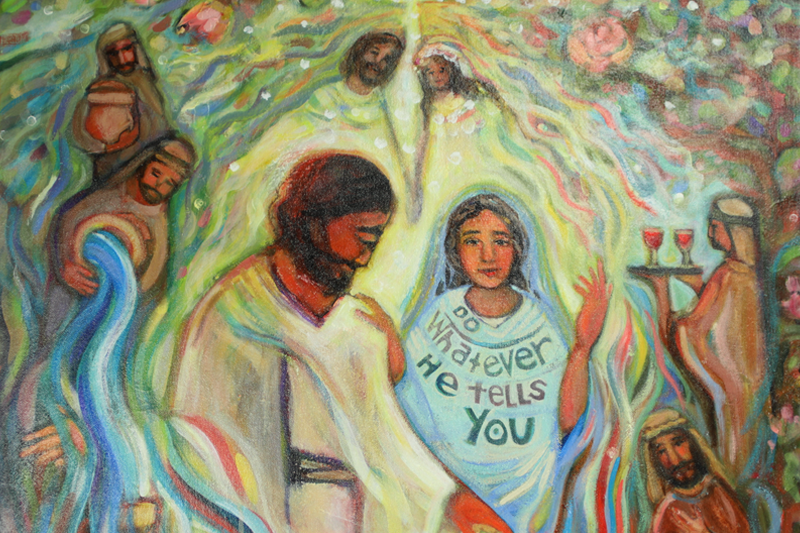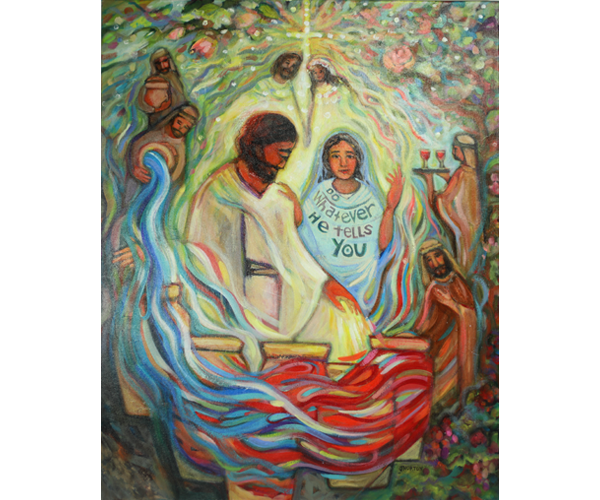Blogs

Mary's Call at Cana
By Emily Lawrence
Thanks to gifts from donors, the Marian Library recently acquired Jen Norton’s painting “The Wedding at Cana.” As Norton tells the story of the piece, following John 2:1-12, she pays close attention to the setting and to Mary’s intercession. For Norton, it is significant that Jesus’ first public miracle occurred at a wedding, the beginning of a journey characterized by a “leap of trust,” much like the kind required for hope in the kingdom of God. This hope, expressed also in the sacrament of marriage, “means walking forth in spite of adversity, getting comfortable with vulnerability and desiring the good of the other,” Norton says. Mary’s modeling of this “leap of trust,” together with her call for us to undertake it ourselves, is central to Marianist spirituality and social action.
Norton draws attention to Jesus performing his first miracle in this setting “on the third day,” tying this sacrament with resurrection hope (John 2:1). She paints a stream of water, which pours out of a jar in the top left corner, flows down the side of the painting, and passes in front of Jesus. At this point, the color of the stream shifts from blue to red. Those who are familiar with John’s Passion narrative may recognize this blue and red as evoking the water and blood that flowed from the side of Christ after a Roman soldier pierced his side with a lance (19:31-37). Shortly before this moment in the narrative, Jesus had entrusted Mary to the care of the beloved disciple, saying, “Woman, behold your son,” and “Son, behold your mother” (19:25-27). Just as Mary was present and active in Jesus’ first public miracle, she was an active witness at Jesus’ ultimate act of love that made salvation possible and began the life of the church.
In the middle of all the activity of the painting stands the Blessed Mother with a key phrase written across her tunic: “Do whatever he tells you” (2:5). Norton notices that in the biblical text, Mary directs this line to unnamed servants who also represent us. Indeed, the foreground leaves space for the presence of the viewer on the other side of the water jars, and Mary’s gaze seems just as fixed on this viewer as on her son’s actions. The Marianists likewise take this charge personally, as exemplified by this quote by Blessed William Joseph Chaminade:
Ours is a work, a magnificent work. If it is universal, it is because we are missionaries of Mary, who has said to us, “Do whatever he tells you.” Each one of us has received from the Blessed Virgin a commission to work at the salvation of our brothers and sisters in the world.
Finally, on the right side of the painting, a servant carries two cups of the water-turned-wine to the married couple, inviting them to taste “the good wine” that had been “kept … until now” (John 2:10). The Gospel story of the Wedding at Cana invites us to take the same “leap of trust” taken by the just-married couple at Cana, by the servants who heeded Mary’s words, by Mary and the beloved disciple at the foot of the Cross, by the founders of the Marianist family and by all who cooperate with God’s grace unfolding in the world. “A true wedding,” Norton says, is “a lifelong, letting go, learning and unlearning sacramental relationship with God,” as it is in all other aspects of life in Christ. As we grow in the life of Christ, she says, we find that “the best wine [the fruits of grace] will be kept for last.” Chaminade, echoing this hope, leaves us with this vision: “What happiness for us if for the rest of our lives we can walk along the beautiful paths of faith, act only by faith, and live only from faith!”
—Emily Lawrence, a graduate assistant in the Department of Religious Studies and the Marian Library, is earning a master’s in theological studies.

“The Wedding at Cana,” by Jen Norton.

